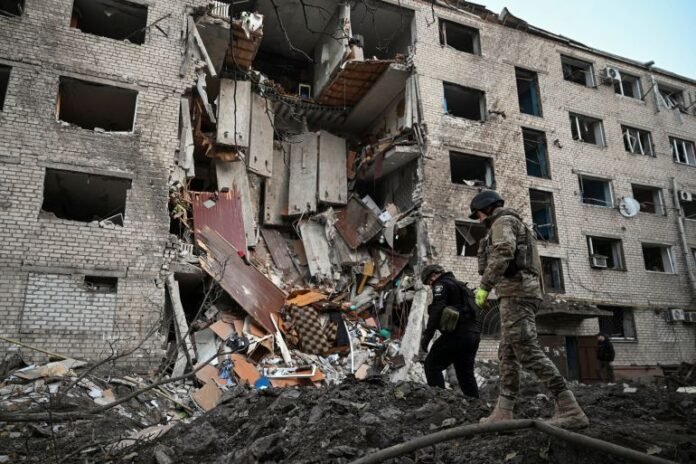‘Dire situation’: Russia gains ground in Ukraine’s Zaporizhia region
Residents flee as Moscow closes in on Huliaipole, a strategic town, using glide bombs and tactics to obscure Russian ground forces.

Published On 18 Nov 202518 Nov 2025
Save
Kyiv, Ukraine – There is tension in the air in Zaporizhzhia, the southeastern Ukrainian city that straddles both banks of the Dnipro River.
In recent weeks, the front line on the left, eastern bank, moved closer and is raging about 40km (25 miles) away from the city that also serves as the administrative capital of the Zaporizhia region.
Recommended Stories
list of 4 itemsend of list
Three-quarters of Zaporizhia have been occupied since 2022, the year Moscow also declared to have officially annexed all of it, along with three more regions – Donetsk, Luhansk and Kherson.
Russia has added earth-shattering glide bombs to its arsenal of drones and missiles that keep the city’s 700,000 residents up and afraid at night.
The heavy bombs, which are out of reach of Ukrainian air defence, can glide for dozens of kilometres and destroy entire apartment buildings.

The front line itself is more audible.
“It’s louder, we hear it from across the river,” Tetiana, a psychologist whose patients feel increasingly alarmed and depressed, told Al Jazeera.
She withheld her last name for security reasons.
Even though life in the city seems to go on – swimming pools and medical centres are open, for instance – Tetiana feels that she and her family may have to pack up and flee soon.
“There’s a feeling that maybe at some point we’ll have to leave,” she said. “There’s a readiness.”
Military analysts are also far from optimistic.
Advertisement
“[Russia] deployed resources more than a month ago to activate their advance on the western flank,” Lieutenant General Ihor Romanenko, former deputy head of Ukraine’s general staff of armed forces, told Al Jazeera.
Tens of thousands of troops keep advancing, seizing several villages and closing in on the town of Huliaipole in eastern Zaporizhia.
The town’s name means “a field to walk around” and reflects its centuries-old importance for defending central Ukraine from invaders from the south – mostly nomadic horsemen from the steppes north of the Black Sea and the Sea of Azov.
These days, Huliaipole serves as a crucial logistical hub – and Russian forces are mere kilometres away.
“The situation became dire, [Russian forces] moved forward and shortened the distance to the town to 4km [2.5 miles], they can even strike it with mortars,” Romanenko said.
Of Huliaipole’s 20,000 residents, only hundreds remain – mostly the elderly who cannot part with their houses, cattle and pets.

What helps the Russian advance in Zaporizhia is an open landscape with sparse trees and villages – unlike in Donetsk up north, where Ukraine has well-fortified strongholds on hills and plenty of villages and towns to hold on to, he said.
Russians also use “couriers”, or wheeled robots topped with smoke bombs that create a dense smokescreen – concealing Russian ground forces from Ukrainian reconnaissance drones, he said.
The fall of Huliaipole may be “fast, possibly without much fighting”, according to Nikolay Mitrokhin, a researcher with Germany’s Bremen University.
The fall “will be a rather strong public-relations blow for Ukrainian forces”, he told Al Jazeera.
Moscow’s forces keep implementing their tactic of narrow, but deep breakthroughs of up to 15km (9.3 miles) into Ukrainian territory wherever they find weak spots in Ukrainian defences, he said.
If the breakthroughs are not eliminated within days – something that often requires only one regiment of Ukrainian storm troopers and auxiliary drone operators – the front line can be maintained, Mitrokhin believes.
If not, he said, within a week or two, each breakthrough becomes a front-line curve as Russia starts to deploy drones, mortars and tanks, build trenches, amass manpower and weaponry.
The problem is not about the lack of Ukrainian reserves but about the slow decision-making by Ukraine’s leaders, top brass and the entire military apparatus, he said.
Advertisement
After patching up yet another breakthrough in the north or the east, Ukrainian commanders keep troops on the ground for weeks fighting for hamlets where Russian forces have firmly entrenched.
The Ukrainians keep losing manpower and resources, while Russians are breaking through elsewhere, he said.
“I’m afraid, with Huliaipole, things will be the same,” Mitrokhin said.
By mid-December, Huliaipole may be encircled by two-thirds, and then Ukrainian forces will start an operation to save it “with convulsions to save the garrison”, Mitrokhin predicted.
“And yet, what was needed in the beginning was just a deployment of a regiment to a necessary place,” he said.
‘Say goodbye’ to Huliaipole
Some Ukrainian observers agree with him, accusing top Ukrainian commander Oleksandr Syrskii of sluggishness and incompetence.
Huliaipole is “yet another victim [of] the chaos of military management and President [Volodymyr Zelenskyy’s] desire to keep Syrskii,” lawmaker Mariana Bezuhla wrote on Facebook on Friday. “Say goodbye to the town … It’s being razed to the ground, bypassed from the sides, but soon the fighting will be in Huliaipole itself.”
“In recent weeks, the enemy has significantly sped up its advance and is not going to slow down,” military analyst Konstantin Mashovets wrote on Telegram on Friday.
Another observer warned of a much larger disaster.
“We’re moving towards a catastrophe of strategic scale that could lead to the loss of our statehood,” Serhiy Sternenko, a popular nationalist blogger, wrote on Telegram on Sunday.
But according to DeepState, a group of Ukrainian military analysts who verify Moscow’s gains and Kyiv’s losses by geolocating photos and videos, things are not that bad.
Russia currently controls some 19 percent of Ukraine’s territory, a mere percentage point up from the fall of 2022.
The point cost Moscow tens of thousands of servicemen, according to Western intelligence, amid economic pressure caused by Western sanctions and Ukraine’s strikes on oil refineries and military infrastructure.








